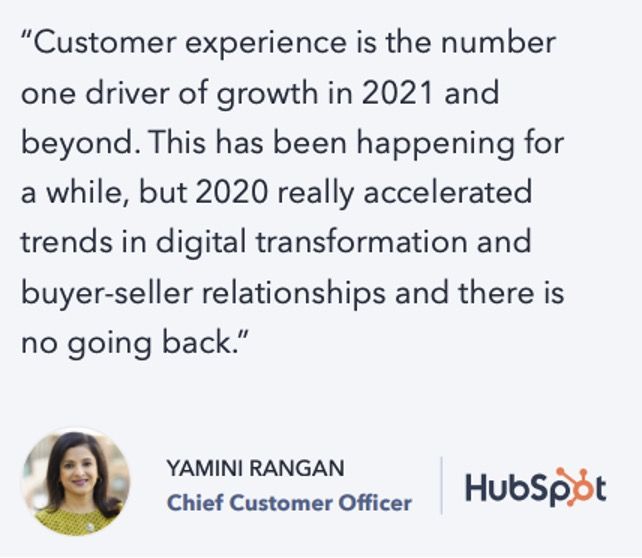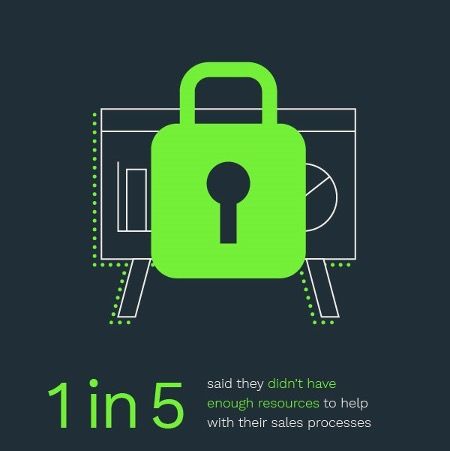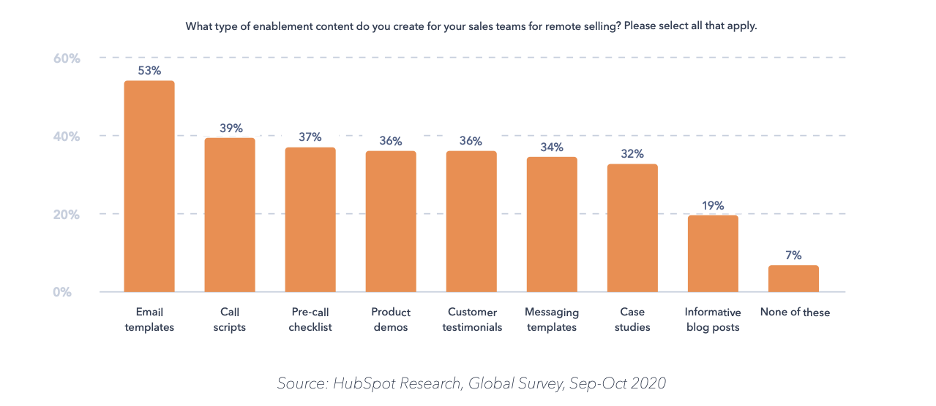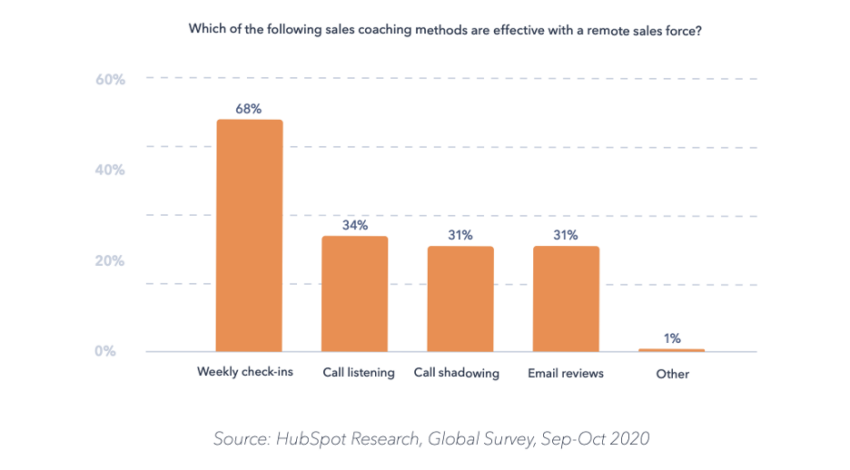The Complete Guide to Creating a Sales Enablement Program
Have you ever thought that it might not be the fault of your sales reps that sales are declining?
“The times they are a-changin.’”
Bob Dylan knew this in 1964 and Ron Burgundy learned this in 2003.
As sales and marketing leaders, we have experienced this change in the last 10 years along with the rapid change that shook the world in March of 2020.
The buying and selling process as we knew it rapidly shifted and in the blink of an eye, we were thrown into a place where we could no longer rely on what was comfortable or what used to work from a sales standpoint.
And as remote selling became the norm, new, unforeseen challenges arose with regard to training, coaching, and sales support.
So, maybe it’s time to beg the question – how can we stop putting so much pressure on our sales reps and give them the tools they need to sell more effectively in an environment that is continuously evolving?
The answer to that question is with sales enablement.
Here’s what it is, why it’s important, and everything you need to know to use it successfully.
#1. What is Sales Enablement?
Sales enablement sets the foundation for an organization’s sales strategy by identifying areas that need improvement or development, as well as outlining the best ways to boost sales productivity with the use of high-quality content.
The importance of content can’t be understated.
Sales enablement should manage the strategy from design to delivery—and make sure it’s easily accessible to sellers. Organizations that use a content strategy achieved 27.1% higher win rates.
When you have an effective sales enablement process in place, your brand will experience some of the benefits below:
- Better experience for your prospect and future customers
- Deeper understanding of buyer personas and their biggest challenges
- Understanding the buyer’s journey
- Knowing what content to provide at what point in the buyer’s journey
- The ability to measure and act on the right metrics
- Designing a training program to continue to education and improve your team
- Establishing sales & marketing alignment
One thing to keep in mind about sales enablement is that it’s an evolving process.
It’s not something that you can set and forget.
In order to continue to provide a positive customer experience and value at each stage of the customer journey, your sales enablement strategy must adapt to meet the needs of your customers.
As Yamini Ragnan, Chief Customer Officer explains,
“Customer experience is the number one driver of growth in 2021 and beyond. This has been happening for a while, but 2020 really accelerated trends in digital transformation and buyer-seller relationships and there is no going back.”

When you provide a better experience, you show your knowledge of their challenges, you become a trusted advisor, not just a salesperson.
Trusted advisors close more deals, shorten sales cycles, and increase overall lifetime value.
#2. Why You Should Care About Sales Enablement
If you aren’t already convinced of the value a sales enablement program can provide, here’s a rundown on what having one can accomplish for your sales team.
In a nutshell, it equips sales reps with the necessary items in the form of research, content, and collateral to make the sales process seamless for prospects, which in turn, shortens sales cycles and increases average deal size.
The goal of a sales representative is to provide value to prospective customers and move deals further and further down the pipeline until they become closed won.
Buyers are now more aware of how automation and other tools that have been utilized in the past affect their own efforts.
They are less likely to respond to generic, unoriginal emails that sound like they’ve been sent to a million others. The business world is now more thoughtful and strategic, affecting how we communicate and address challenges.
Sales reps who communicate using personalization are more likely to win the deal.
These reps understand the challenges of their prospects and have solutions that are engineered for this customer.
They will customize their pitch to answer a prospect’s specific needs, rather than using a generic approach.
If the sales rep is responsible for closing deals on the front line, the job of a sales leader is to drive growth from the top.
Sales enablement is built to support the sales reps in their process of taking a prospect from cold to closed. However, according to a recent survey from Datadwell, 1 in 5 (19%) sales reps who responded said they didn’t have enough resources to help with their sales processes.

Without a dedicated sales enablement strategy complete with the marketing resources required to produce the items needed to educate customers and build trust throughout the sales cycle, sales pitches can fall flat, feel generic, or ultimately miss the mark because there is a disconnect between what the customer needs and what the salesperson wants.
The good news is that while it may seem like a big undertaking, enacting a sales enablement plan will be a worthwhile investment as it will directly impact your organizations bottom line.
And, it’s not hard to get started.
#3. What is Involved in Sales Enablement?
There are a few key elements to sales enablement.
As you go through the act of implementing your strategy, you will begin to understand what is needed for your organization to succeed.
Methodology
To get started with sales enablement, you need to have the right mindset.
It will take buy-in from multiple teams and leaders to create a cohesive strategy that can be rolled out and implemented effectively.
There are many steps in the process, including;
• Developing a strategy,
• Defining goals & objectives,
• Auditing / mapping your buyer’s journey
• Identifying what offers appeal to which customer segments,
• Deciding how to prioritize content production, and
• Making sure that enough resources are available to implement the program effectively
For sales enablement to work, you have to “want” it. Therefore, it must be generally understood and accepted beforehand that there is a minimum level of investment that has to take place in order to get the program off the ground.
Content
Content is the beating heart of sales enablement.
If you don’t have quality and consistent content that speaks to the needs of your customer, the strategy will not work.
Content is a collaborative process with marketing. Together, the sales team shares the questions and information they hear regularly from prospects and then marketing uses this information to plan and create content that will speak directly to customers at times when they have objections or lack understanding during the buyer’s journey.
For instance, if there is a trend where customers continuously express concern about a specific product functionality, a piece of content can be produced to provide further education around the point of contention, and the sales rep will be armed with exactly what they need when this objection occurs.
Or maybe it becomes clear that a number of prospects who were ready to sign on the dotted line get cold feet when the contract hits their inbox because the next steps are unclear.
In that case, content can be used to set expectations and demystify what happens next, bringing more trust and transparency where before, there was none.
Also, it’s important to remember that content can take various forms. Phone scripts, email templates, blog articles, web pages, case studies, webinars, events, videos, podcasts, even LinkedIn posts, can all fall under the umbrella of sales enablement content.

Deciding which medium to use for each piece of content required for sale enablement will be dependent on how your audience prefers to receive and consume information and at what stage of the buyer’s journey the prospect is in.
Prospects who are near the top of the funnel might do better with a more self-service approach.
This might come in the form of an email with several pieces of blog or video content that they can view at their leisure, based on their specific pain points and/or goals.
On the flip side, a prospect who is more familiar with the product or service and is closer to taking action should be provided a more hands-on, personalized experience, which could be something like an invite to a special event where more one-on-one conversation can occur.
Sales & Marketing Alignment
As mentioned before, a key element of a successful sales enablement process is the alignment between sales & marketing.
Both departments have to work together to in order for them to each reach their separate goals.
Sales teams need to be able to sell in a way that resonates with the buyer’s needs. Marketing teams need to understand the buyer’s needs in order to create content that will attract them.
At the end of the day, it is critical for both teams to cooperate and agree on where to prioritize in order for the program to grow and succeed.
Tools
A good craftsman will say there is the right tool for the job. The same is true for sales enablement.
With or without sales enablement, I can make the case that all organizations need a good CRM to track sales & marketing information, but it’s even more crucial in this process.
Many CRMs may have tools like engagement tools, intelligence tools, communication tools, role playing tools, call coaching, and many more.
A major part of sales enablement is tracking data and making informed decisions based on that data, so it’s important to consistently track and analyze the data.
Training & Coaching
While the sales team may be accustomed to pulling things together on the fly, sales enablement is a process of preparing for success. This may be a new strategy for some, which is why it’s important to continuously train, coach, and remind reps of the resources at their disposal.
A successful sales enablement program will provide knowledge of product, market, and company information in an engaging way. It will also facilitate collaboration between the sales group and other internal departments to make sure that all necessary resources are available.
On top of that, all of the resources created to support the program must be easily accessible and available in a way that provides basic information about what each resource is, and when to use it.
It is not uncommon for a business to launch a sales enablement strategy, only to find that the sales reps aren’t using the resources due to lack of communication and training around the what, where, and when for each piece of content.
In a remote or even hybrid environment, how you communicate and coach reps matters. With regard to sales enablement, this should happen early in their onboarding and often during their tenure.

#4. Who Should Implement Sales Enablement
Now, you might be wondering whether your organization should develop a sales enablement program.
And as we’ve discussed, sales enablement programs can improve a company’s sales, customers’ experience, and employee engagement.
It will build a scalable, predictable and repeatable sales process that achieves quota, however, not all businesses are set up to be successful with sales enablement right off the bat.
To understand if this type of initiative is right for your organization, ask yourself a few questions:
• Is there a unified message across all sales reps?
• Is marketing & sales on the same page?
• Do our reps have the content they need to be successful?
• Does our leadership team struggle to see the value in content?
If you answered “no” to these questions, you may want to consider implementing sales enablement at your organization.
(In some cases, you may answer “yes” but you are expanding into new markets, or the company is experiencing high growth. In this case, a unified sales strategy, process, and shared content will be key to that growth.)
Building Your Sales Enablement Program: Final Thoughts
While sales enablement is a growing aspect of sales organizations all across the globe, it’s important to remember that there is no one-size fits all approach. What it looks like at one company does not mean it will look like that at another.
If there was one thing to take away from this article is to take a step back from your current sales process and ask one important question.
Does my selling process match my customers’ buying process?
According to the 5th Annual CSO report, organizations that aligned their internal selling processes to the customer’s path dynamically saw 17.9% higher win rates and 11.8% higher quota attainment than those who didn’t.
If you are thinking about sales enablement, reach out to other leaders in your organization and start having conversations and begin to move forward with building a winning process.
It just might be the initiative that takes your business from good to great.